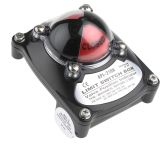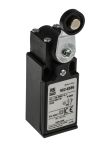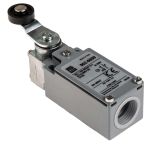Limit Switches
Limit switches are electromechanical devices that play a crucial role in regulating machinery. They are essential for ensuring operational safety and efficiency in industrial environments. Limit switches are a contact proximity sensor device that consists of an actuator mechanically linked to a set of output contacts. When an object comes into contact with the actuator, the limit switch sensor operates the contacts to make or break an electrical connection. Limit sensor switches are vital in preventing machinery malfunctions and accidents, thus maintaining smooth and safe operations.
Limit Switch Makeup
Limit switches are made up of three key components:
- Actuator Head: The actuator is the part of the switch that makes physical contact with the object. In some limit switches, the actuator is attached to an operating head which translates a rotary, linear, or perpendicular motion to open or close the electrical contacts of the switch.
- Switch Body: The switch body is the component containing the electrical contact mechanism, the contacts within the body open or close the electrical circuit when the actuator is activated.
- Receptacle/Terminals: The component containing the terminal screws or screw/clamp assembly necessary for wiring purposes.
Types of Limit Switches
Roller Lever Limit Switch: The roller lever limit switch features a lever with a roller at the end, designed to detect objects in motion. Common applications include conveyor belts and automated systems where the limit switch types must withstand frequent contact.
Plunger Limit Switch: The plunger limit switch is ideal for space-constrained environments due to its compact, straightforward design. It is commonly used in machinery where direct, linear contact is required.
Whisker (or Cat Whisker) Limit Switch: The cat whisker limit switch is highly sensitive, making it suitable for detecting light objects or precise movements. It is often used in delicate applications such as robotics or small-scale automation.
Forked Limit Switch: The forked limit switch operates by detecting objects passing through its forked opening, making it perfect for conveyor systems and assembly lines where precise positioning is crucial.
Rotary Limit Switch: The rotary limit switch converts rotational motion into electrical signals, ideal for applications involving rotating machinery, such as wind turbines and cranes.
Heavy Duty Limit Switch: The heavy-duty limit switch is robust and designed for harsh industrial environments, such as mining and heavy manufacturing, where durability and reliability are essential.
Adjustable Limit Switch: The adjustable limit switch allows for precise calibration and positioning, making it suitable for applications requiring exact control, such as CNC machines and automated assembly lines.
Safety Limit Switch: The safety limit switch enhances machinery safety by ensuring critical operations stop immediately upon detecting unsafe conditions, crucial in protecting workers and equipment.
Miniature Limit Switch: The miniature limit switch is compact and ideal for use in electronics and light industries, where space is limited, and precision is required.
Push Button Limit Switch: The push button limit switch is convenient and easy to use, often employed in control panels and user interfaces where manual operation is frequent.
Actuator Types
Limit switches are available with a wide range of actuator types. The type of actuator used can be determined by the mounting position, force required and objects to be detected.
- Rotary Lever: with lever actuators, a cam or plate hits the end of the lever arm which in turn rotates a shaft and operates the contacts in the switch. The rotation may be spring returned (momentary) or maintained.
- Plunger: Plunger types are best where short controlled machine movements are present or where mounting space does not permit a lever type.
- Cat Whisker or Coil Spring: Longer actuators with a coil wire that can be moved/bent in multiple directions. Typically used in conveying applications to count objects as they pass by.
- Forked: Used with maintained contacts, consisting of two roller levers. One roller will trip the switch and when the second is moved to the opposite direction it will reset the switch.
Limit Switch Configuration Types
A Single Pole Double Throw (SPDT limit switch) has one input and two outputs, allowing it to switch between two circuits. This configuration is useful in applications where a single input needs to alternate between two outputs, such as in basic light control or toggling between two states. For instance, an SPDT limit switch is ideal for a conveyor system where a single switch needs to alternate the direction of the conveyor belt by switching the motor's power supply between forward and reverse circuits.
In contrast, a Double Pole Double Throw (DPDT limit switch) has two inputs and four outputs, functioning like two SPDT switches operated by a single actuator. It can control two separate circuits simultaneously, making it suitable for more complex operations requiring simultaneous switching of multiple connections. A DPDT limit switch is preferable in situations where a machine needs to simultaneously change the direction of two motors, such as in a robotic arm that requires precise coordinated movement of multiple joints.
Applications of Limit Switches
Limit switches are critical in various industries, including manufacturing lines, packaging plants, and robotics. In manufacturing lines, limit switches ensure machinery operates safely and efficiently by detecting the presence or absence of objects, thereby preventing collisions and maintaining the workflow.
For example, they can stop a conveyor belt when an item reaches the end of the line or control the positioning of machine tools. In packaging plants, limit switches play a crucial role in automating packaging processes. They can detect the position of packages, ensuring accurate labeling, filling, and sealing operations. This automation improves precision and reduces manual labor, enhancing overall productivity.
In the realm of automation, limit switches perform specific tasks such as stopping a conveyor belt when an object is detected at a certain point, controlling the movement of a machine arm to pick and place items accurately, and ensuring the correct alignment of components in assembly lines. These applications highlight the importance of limit switches in maintaining safety, efficiency, and reliability in industrial operations.
Limit Switches in the Philippines
Explore our wide range of limit switch sensors available in the Philippines to enhance the safety and efficiency of your industrial operations. Whether you need robust solutions for harsh environments or precise switches for automation, RS Philippines has the perfect limit switches for your needs. For unique requests, and to get detailed pricing information, contact our customer support service today, or visit our website!
Popular Searches
Related links
- Limit & Position Switches
- Telemecanique Sensors XCSM Series Roller Plunger Safety Limit Switch IP66 IP68 Zamak Zinc Alloy
- Omron Roller Plunger Limit Switch SPDT, 250V ac Max
- Telemecanique Sensors XCKP Series Roller Lever Plunger Limit Switch IP66 DPST 240V
- Telemecanique Sensors XESP Series Roller Limit Switch IP66 Metal Housing, 10A Max
- Siemens 3SE5 Series Roller Limit Switch IP66 Metal Housing 4A Max
- Telemecanique Sensors XCMH Series Roller Plunger Limit Switch IP66 2P 240V ac Max,
- Telemecanique Sensors XCKD Series Roller Lever Plunger Limit Switch IP66 DP 240V ac



















